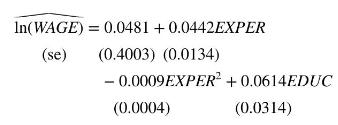Consider the model in Example 10.5. Suppose we have the idea that the effect of education may
Question:
Consider the model in Example 10.5. Suppose we have the idea that the effect of education may differ for individuals who have siblings. Suppose SIBS = number of siblings, which we assume is exogenous. We add to the model the variable \(E D U C \times S I B S\).
a. Assuming we treat \(E D U C\) as endogenous, what type of variable is \(E D U C \times S I B S\) ? Is it exogenous or endogenous? Explain your reasoning.
b. In addition to MOTHEREDUC and FATHEREDUC, are MOTHEREDUC \(\times\) SIBS and FATHEREDUC \(\times\) SIBS potentially useful IV? Explain how they satisfy, or might satisfy, the three conditions IV1-IV3.
c. Using OLS with a large sample of individuals, we find the estimated coefficient of EDUC to be \(0.0903(t=46.74)\) and the estimated coefficient of \(E D U C \times S I B S\) to be \(-0.0001265(t=-0.91)\). Explain why we should not simply omit the variable \(E D U C \times S I B S\) in the wage equation based on this result.
d. The first-stage equations for \(E D U C\) and \(E D U C \times S I B S\) include \(E X P E R, E X P E R^{2}\), and the four variables listed in (b). The \(F\)-tests for the joint significance of the IV have \(p\)-values of 0.0000 . Can we safely conclude that our IV are strong for both \(E D U C\) and \(E D U C \times S I B S\) ?
e. We calculate the residuals from the two first-stage equations. Let the residuals from the \(E D U C\) equation be \(\hat{v}_{1}\) and the residuals from the \(E D U C \times S I B S\) equation be \(\hat{v}_{2}\). We estimate the structural model by OLS including both \(\hat{v}_{1}\) and \(\hat{v}_{2}\) as explanatory variables. Their \(t\)-values are -10.29 and -1.63 , respectively, and the joint \(F\)-test of their significance is 55.87. Can we safely conclude that both \(E D U C\) and \(E D U C \times S I B S\) are endogenous?
f. Using IV/2SLS, we find that the estimated coefficient of \(E D U C\) is 0.1462 with a \(t\)-value of 25.25, and the estimated coefficient of \(E D U C \times\) SIBS is 0.0007942 with a \(t\)-value of 4.53 . The estimated covariance between these two coefficients is \(4.83 \times 10^{-7}\). Estimate the marginal effect of another year of education on wages for a person with no siblings. What is the estimated marginal effect of education if a person has five siblings?
Data From Example 10.5:-
In addition to education a worker's experience is also important in determining their wage. Because additional years of experience have a declining marginal effect on wage use the quadratic model

where EXPER is years of experience. This is the same specification. We assume that EXPER is an exogenous variable that is uncorrelated with the worker's ability and therefore uncorrelated with the random error \(e\). Two instrumental variables for years of education, \(E D U C\), are mother's and father's years of education, MOTHEREDUC and FATHEREDUC, introduced in the previous examples. The first-stage equation is

Using the 428 observations in the data file mroz the estimated first-stage equation is reported in Table 10.1. The IV/2SLS estimates, with correctly computed standard errors, are

The estimated return to education is approximately \(6.1 \%\), and the estimated coefficient is statistically significant with a \(t=1.96\).

Step by Step Answer:

Principles Of Econometrics
ISBN: 9781118452271
5th Edition
Authors: R Carter Hill, William E Griffiths, Guay C Lim





